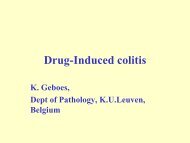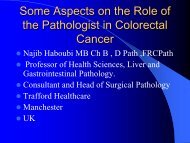FNA of Salivary glands a practical approach for Sudan
FNA of Salivary glands a practical approach for Sudan
FNA of Salivary glands a practical approach for Sudan
Create successful ePaper yourself
Turn your PDF publications into a flip-book with our unique Google optimized e-Paper software.
<strong>FNA</strong> OF SALIVARY GLANDS: A<br />
PRACTICAL APPROACH
<strong>FNA</strong> <strong>of</strong> <strong>Salivary</strong> Glands:<br />
Challenges<br />
• Wide range <strong>of</strong> neoplastic and non-neoplastic<br />
lesions<br />
• Cytological overlap between the different<br />
benign and malignant tumors
Should We Try <strong>FNA</strong> <strong>of</strong><br />
<strong>Salivary</strong> Glands First?<br />
• Not every salivary gland swelling is a<br />
neoplasm<br />
• A swelling in a salivary gland area may not be<br />
<strong>of</strong> a salivary gland origin<br />
• Accuracy is reliable and helps in overall<br />
patient management.<br />
90% <strong>for</strong> pleomorphic adenoma<br />
60% <strong>for</strong> Warthin’s tumor<br />
50% <strong>for</strong> malignancy
<strong>FNA</strong> <strong>of</strong> <strong>Salivary</strong> Glands: Pros<br />
• Helps in planning surgery with total excision<br />
and nerve sparing in benign lesions<br />
• Helps plan <strong>for</strong> chemo / XRT in lymphoma,<br />
anaplastic ca, or metastatic ca<br />
• Establish Dx in pts with poor surgical risk
<strong>FNA</strong> <strong>of</strong> <strong>Salivary</strong> Glands: Cons<br />
• 75% <strong>of</strong> tumors are pleomorphic adenomas<br />
• Recurrence at needle tract<br />
• Malignant trans<strong>for</strong>mation may not be<br />
detected (sampling issue)
<strong>FNA</strong> <strong>of</strong> <strong>Salivary</strong> Glands:<br />
Complications<br />
• Vagus Nerve Reaction – Syncope<br />
• Bleeding<br />
• Infection<br />
However; Very Rare
Methods and Sample<br />
Preparation<br />
• Multiple passes from different<br />
areas (good sampling)<br />
• Both Romanowsky (Diff Quik<br />
or Giemsa) and Papanicolaou<br />
stains are essential!<br />
• Cell block is essential
Normal <strong>Salivary</strong> Gland:<br />
Histological landmarks<br />
• Parotid: pure serous. May have an<br />
intraparotid lymph node<br />
• Submandibular: mucinous<br />
• Sublingual: mixed<br />
• Minor: mucinous, serous, or mixed
Normal <strong>Salivary</strong> Gland:<br />
Cytology<br />
Acinar cells<br />
• Groups <strong>of</strong> acini<br />
• Peripheral uni<strong>for</strong>m<br />
nuclei<br />
• Granular cytoplasm if<br />
serous<br />
• Vacuolated cytoplasm if<br />
mucinous
Normal <strong>Salivary</strong> Gland:<br />
Cytology<br />
Ductal cells<br />
• Cuboidal or columnar<br />
• Honey comb<br />
• Palisading row<br />
• Small amount <strong>of</strong><br />
cytoplasm<br />
• Small, uni<strong>for</strong>m nuclei<br />
• N/C ratio on the high side
Normal <strong>Salivary</strong> Gland:<br />
Cytology<br />
Myoepithelial cells<br />
• Rare spindled<br />
• Scant cytoplasm<br />
• Small slender nuclei<br />
• Isolated or at<br />
periphery <strong>of</strong> acinar<br />
groups
Normal <strong>Salivary</strong> Gland:<br />
Cytology<br />
• Rare oxyphilic cells<br />
are normally<br />
encountered in<br />
older individuals
<strong>Salivary</strong> Gland Tumors<br />
Parotid Submandidular Sublingual Minor<br />
Frequency 80% 10% Rare 10%<br />
Benign /<br />
Malignant ratio<br />
4:1 2:1 1:4 2:3<br />
% <strong>of</strong> all<br />
malignant tumors<br />
occur in<br />
65% 15% Rare 20%
Algorithm chart <strong>for</strong> salivary gland <strong>FNA</strong><br />
<strong>FNA</strong> Findings<br />
Abundant matrix &<br />
cells<br />
Predominant cells<br />
& little or no<br />
matrix
<strong>FNA</strong> Findings<br />
Algorithm chart<br />
<strong>for</strong> salivary<br />
gland <strong>FNA</strong><br />
Abundant Matrix & cells<br />
Predominant Cells & little or<br />
no matrix<br />
Fibrillar myxoid and<br />
chondroid<br />
Pleomorphic adenoma
<strong>FNA</strong> Findings<br />
Algorithm chart <strong>for</strong><br />
salivary gland <strong>FNA</strong><br />
Abundant Matrix & cells<br />
Predominant Cells & little or<br />
no matrix<br />
Fibrillar myxoid and chondroid<br />
Round hyaline balls<br />
Pleomorphic adenoma<br />
ACCa
Algorithm chart <strong>for</strong> salivary gland <strong>FNA</strong><br />
<strong>FNA</strong><br />
Findings<br />
Abundant Matrix &<br />
cells<br />
Predominant Cells<br />
& little or no matrix<br />
Fibrillar myxoid and<br />
chondroid<br />
Round hyaline balls<br />
Basaloid Oncocytic Lymphocytes Squamoid<br />
ACCa<br />
Pleomorphic<br />
adenoma
Algorithm chart <strong>for</strong> salivary gland <strong>FNA</strong><br />
<strong>FNA</strong><br />
Findings<br />
Abundant Matrix &<br />
cells<br />
Predominant Cells<br />
& little or no matrix<br />
Fibrillar myxoid and<br />
chondroid<br />
Round hyaline balls<br />
Basaloid<br />
Oncocytic Lymphocytes Squamoid<br />
ACCa<br />
Pleomorphic<br />
adenoma<br />
Solid ACCa<br />
BCA<br />
BCACa<br />
Met BCCa
Algorithm chart <strong>for</strong> salivary gland <strong>FNA</strong><br />
<strong>FNA</strong><br />
Findings<br />
Abundant Matrix &<br />
cells<br />
Predominant Cells<br />
& little or no matrix<br />
Fibrillar myxoid<br />
and chondroid<br />
Round hyaline balls<br />
Basaloid<br />
Oncocytic<br />
Lymphocytes<br />
Squamoid<br />
ACCa<br />
Oncocytoma<br />
Oncocytic ca<br />
Warthin’s tumor<br />
Acinic cell ca<br />
Pleomorphic<br />
adenoma<br />
Solid ACC<br />
BCA<br />
BCACa<br />
MECa onco var<br />
Met BCCa
Algorithm chart <strong>for</strong> salivary gland <strong>FNA</strong><br />
<strong>FNA</strong><br />
Findings<br />
Abundant Matrix<br />
& cells<br />
Predominant<br />
Cells & little or no<br />
matrix<br />
Fibrillar myxoid<br />
and chondroid<br />
Round hyaline<br />
balls<br />
Basaloid<br />
Oncocytic<br />
Lymphocytes<br />
Squamoid<br />
ACCa<br />
Oncocytoma<br />
Oncocytic ca<br />
Warthin’s tumor<br />
Acinic cell ca<br />
Pleomorphic<br />
adenoma<br />
Solid ACCa<br />
BCA<br />
BCACa<br />
Met BCCa<br />
MECa onco var<br />
Warthin’s tumor<br />
LN<br />
LEL<br />
Branchial cleft cyst<br />
Sialadenitis
Algorithm chart <strong>for</strong> salivary gland <strong>FNA</strong><br />
<strong>FNA</strong><br />
Findings<br />
Abundant<br />
Matrix & cells<br />
Predominant<br />
Cells & little or<br />
no matrix<br />
Fibrillar myxoid<br />
and chondroid<br />
Round hyaline<br />
balls<br />
Basaloid<br />
Oncocytic<br />
Lymphocytes<br />
Squamous &<br />
Squamoid<br />
Pleomorphic<br />
adenoma<br />
ACCa<br />
Solid ACCa<br />
BCA<br />
BCACa<br />
Met BCCa<br />
Oncocytoma<br />
Oncocytic ca<br />
Warthin’s tumor<br />
Acinic cell ca<br />
MECa onco var<br />
Warthin’s tumor<br />
LN<br />
LEL<br />
Branchial cleft cyst<br />
Branchial Cleft<br />
Cyst<br />
Sialadenitis<br />
MECa<br />
SCCa<br />
Sialadenitis
Algorithm chart <strong>for</strong> salivary gland <strong>FNA</strong><br />
<strong>FNA</strong><br />
Findings<br />
Abundant Matrix & cells<br />
Predominant Cells & little or no matrix<br />
Fibrillar myxoid<br />
and chondroid<br />
Round hyaline<br />
balls<br />
Basaloid<br />
Oncocytic<br />
Lymphocytes<br />
Squamoid<br />
ACCa<br />
Oncocytoma<br />
Oncocytic ca<br />
Warthin’s tumor<br />
Acinic cell ca<br />
Branchial Cleft Cyst<br />
Sialadenitis<br />
MECa<br />
SCCa<br />
Pleomorphic<br />
adenoma<br />
Solid ACCa<br />
BCA<br />
BCACa<br />
Met BCCa<br />
MECa onco var<br />
Warthin’s tumor<br />
LN<br />
LEL<br />
Branchial cleft cyst<br />
Sialadenitis
Group 1:<br />
Abundant fibrillar myxoid<br />
and / or chondroid stroma
Pleomorphic Adenoma<br />
• Cellularity: moderate to high<br />
• Epithelial cells:<br />
Uni<strong>for</strong>m cells<br />
Cohesive clusters and sheets<br />
Embede in loose fibrillar &/or<br />
myxoid stroma<br />
Distinct cytoplasm<br />
Bland nuclei with<br />
fine chromatin<br />
small nucleoli
Pleomorphic adenoma<br />
• Fibrillar myxoid or chondroid stroma<br />
containing spindle or round to oval stromal<br />
cells occasionally with halos<br />
• Stroma is metachromatic on DQ and pale<br />
blue to clear on pap stain<br />
• Metaplastic squamous cells may be present
Pleomorphic adenoma with<br />
abundant spindle myoepithelial<br />
cells
Pleomorphic Adenoma with<br />
plasmacytoid myoepithelial<br />
cells
Surgical specimen<br />
S06-12750<br />
Parotid tumor
Carcinoma ex Pleomorphic<br />
Adenoma (CA-ex-PA)<br />
• Recent rapid increase in size<br />
• 4% <strong>of</strong> all salivary tumors<br />
• 12% <strong>of</strong> all malignant salivary tumors<br />
• 6% <strong>of</strong> all pleomorphic adenomas<br />
• 6 th to 7 th decade, 10 yrs older than <strong>for</strong> PA<br />
• Parotid, submandibular, palate<br />
• Mostly adenocarcinoma but any epithelial<br />
malignancy can occur
Pleomorphic adenoma, DDX<br />
• Monomorphic adenomas (basal cell<br />
adenoma, oncocytoma, myoepithelioma)<br />
• Adenoid cystic carcinoma<br />
GFAP and CD57 positive in PA but not in ACCa<br />
• Mucoepidermoid carcinoma<br />
• Undifferentiated carcinoma<br />
• Metastatic carcinoma
Group 2:<br />
Abundant hyaline balls
Adenoid Cystic Carcinoma<br />
• Most common malignancy <strong>of</strong> minor salivary<br />
<strong>glands</strong><br />
• In parotid gland is less common than<br />
mucoepidermoid or acinic cell carcinoma<br />
• Any age but, mostly affects women in 4 th and<br />
5 th decade<br />
• Slow growing but relentless with many<br />
recurrences
Adenoid Cystic Carcinoma<br />
• Cellularity is variable, but usually high<br />
• Spherical 3D aggregates, sheets, and / or<br />
cords <strong>of</strong> uni<strong>for</strong>m epithelial cells with basaloid<br />
look<br />
• Dark nuclei.<br />
• Small nucleoli may be present<br />
• Epithelial cells surrounding spherical space<br />
filled with hyaline or may be empty.
Adenoid Cystic Carcinoma<br />
DDx and pitfalls:<br />
• Basal cell adenoma<br />
• Basal cell adenocarcinoma<br />
• Overlying skin tumors with basaloid<br />
differentiation<br />
• Benign mixed tumor<br />
• Undifferentiated carcinoma<br />
• PLGA
Group 3:<br />
Predominantly basaloid cells<br />
• Solid ACCa<br />
• BCA<br />
• BCACa<br />
• Met BCC<br />
• Skin adenxal tumors
Solid (poorly<br />
differentiated)<br />
Adenoid Cystic<br />
Carcinoma<br />
• Poorly differentiated<br />
tumors will show more<br />
<strong>of</strong> the large sheets and<br />
clusters <strong>of</strong> basaloid<br />
cells with few or no<br />
rosettes or hyaline<br />
globules.
Basal cell adenoma<br />
• Mostly in parotid gland in adults<br />
• Small uni<strong>for</strong>m epithelial cells in sheets, cords,<br />
micr<strong>of</strong>ollicles, or single<br />
• Round to oval uni<strong>for</strong>m nuclei with invisible<br />
nucleoli<br />
• High N / C ratio<br />
• Scant to no stroma
Basal cell adenoma: DDX<br />
• Basal cell adenocarcinoma<br />
• Poorly differentiated adenoid cystic carcinoma<br />
• BCCa <strong>of</strong> overlying skin<br />
• Skin adenxal tumors with basaloid<br />
differentiation, e.g. cylindoma<br />
• pleomorphic adenoma<br />
• PLGA
Basal cell carcinoma <strong>of</strong> overlying skin
Cylindroma <strong>of</strong> overlying skin
Group 4:<br />
Predominantly oncocytic<br />
cells<br />
• Oncocytoma<br />
• Oncocytic ca<br />
• Warthin’s tumor<br />
• Acinic cell ca<br />
• MECa onco var<br />
• Plasmacytoid variant <strong>of</strong> myoepithelioma
Oncocytoma<br />
• Mostly in the parotid gland<br />
• Usually high cellularity<br />
• Large cells with abundant eosinophilic<br />
cytoplasm singly or in clusters<br />
• Round to oval centric or eccentric nuclei with<br />
prominent nucleoli. Some nuclear atypia may be<br />
observed<br />
• Clean background
PASD
Oncocytoma, DDx<br />
• Oncocytic carcinoma<br />
Atypia<br />
High Ki 67 (MIB 1)<br />
PTAH and AMA +<br />
• Warthin's tumor<br />
Lymphocytic infiltrate<br />
Dirty background<br />
• Acinic cell carcinoma<br />
Alpha-1 AT +<br />
PASD +<br />
PTAH and AMA -
Warthin's Tumor<br />
• Lympho-epithelial neoplasm<br />
• Almost exclusively in parotid gland<br />
• About 6% <strong>of</strong> all parotid tumors<br />
• Most common bilateral salivary tumor<br />
• Most patients are > 40<br />
• Men > women<br />
• Increasing in women due to smoking
Warthin's Tumor<br />
• Oncocytes in monolayer sheets, clusters or<br />
single<br />
• Large central nuclei with prominent nucleoli<br />
• Pleomorphic lymphocytes<br />
• Dirty background, cell debris and cyst content<br />
• DDx: muco-epidermoid ca, oncocytoma, benign<br />
lymphoepithelial lesion
Warthin’s tumor with hyalin globules?!
Acinic Cell Carcinoma<br />
• Majority are in the parotid gland (80%)<br />
• Slightly more in women<br />
• Even age distribution from young adults to old<br />
• 4% in < 20 yrs<br />
• Usually high cellularity<br />
• Sheets, cords or acinar structures <strong>of</strong> bland cells<br />
with cytoplasmic granules (red on DQ stain)<br />
• Cells may also be clear and contain glycogen
Acinic Cell Carcinoma<br />
• Isolated tumor cells with vacuolated or foamy<br />
cytoplasm with vesicular nuclei<br />
• Bare nuclei <strong>of</strong> degenerated cells<br />
• Intranuclear pseudo-inclusions<br />
• More atypia and pleomorphism in poorly<br />
differentiated cases
Normal
Acinic Cell Carcinoma<br />
DDx:<br />
• Benign salivary acini<br />
• Tumors with oncocytic cells:<br />
Oncocytoma, oncocytic carcinoma, plasmacytoid<br />
variant <strong>of</strong> myoepithelioma, mucoepidermoid ca<br />
• Metastatic adenocarcinoma<br />
RCC with granular cells
Acinic Cell Carcinoma<br />
Normal salivary<br />
Acinic cell carcinoma<br />
Cellularity Low, cohesive High, dyshesive<br />
Ductal cells Present Absent<br />
Fat cells May be noted Absent<br />
Acini Well <strong>for</strong>med Poorly <strong>for</strong>med<br />
Cells Uni<strong>for</strong>m Some variability<br />
Nuclei Bland and small Some atypia
Mucoepidermoid Carcinoma<br />
• Mostly in the parotid gland (45%)<br />
• Minor salivary <strong>glands</strong> especially in the palate<br />
• Most common malignant salivary gland<br />
tumor in children and adults
Mucoepidermoid Carcinoma<br />
• Cellularity is variable, usually high; however,<br />
hypocellular if cystic<br />
Squamous cells; Mature to moderately<br />
differentiated, singly or in loose clusters<br />
Glandular mucin producing cells; Either columnar,<br />
signet – ring, or polygonal with vacuolated<br />
cytoplasm<br />
Intermediate cells; metaplastic cells with<br />
cytoplasmic mucin
Mucoepidermoid Carcinoma<br />
• Mild nuclear atypia<br />
• Lymphoid cells may be present<br />
• High - grade tumors show less <strong>of</strong> the welldifferentiated<br />
mucin producing cells and<br />
more <strong>of</strong> the intermediate and squamous cells<br />
• Usually lacks stromal fragments
LG ME<br />
HG ME<br />
HG ME
Mucoepidermoid Carcinoma<br />
DDx and pitfalls:<br />
• Mucocele (false negative in low - grade<br />
hypocellular cystic lesions)<br />
• Warthin's tumor particularly with mucinous<br />
metaplasia (usually older age)<br />
• Metastatic squamous carcinoma<br />
• Metastatic adenocarcinoma (high grade ME)
Mucocele<br />
• Abundant mucus<br />
• Muciphages<br />
• Rare epithelial cells in true<br />
mucocele<br />
• No epithelium in<br />
extravasation mucocele<br />
• Normal salivary tissue +/-<br />
• DDx: WD ME ca
Unknown case with oncocytic<br />
cells: history<br />
• 65 y/o Hispanic male currently in prison<br />
presents with enlarged right parotid gland.<br />
He gave a vague h/o adenocarcinoma<br />
removed from behind his right ear many<br />
years earlier (up to 40 years)
Unknown case with oncocytic<br />
cells: diagnosis<br />
• Low grade oncocytic neoplasm<br />
Abundant cellularity, Dyshesion, and Mild atypia<br />
• DDx<br />
Acinic cell ca, but a1AT is negative and PASD is<br />
weak to negative<br />
ME ca, but mucin is negative<br />
Plasmacytoid variant <strong>of</strong> myoepithelioma S100 +,<br />
but SMA is negative<br />
Oncocytoma / oncocytic ca (S100 +)<br />
• Definitive dx pending surgical excision
Group 5: aspirates with many<br />
lymphocytes<br />
• Warthin’s tumor<br />
• Lymph node<br />
• Lympho-epithelial lesion<br />
• Branchial cleft cyst<br />
• Sialadenitis
Group 6: aspirates with many<br />
squamous / squamoid cells<br />
• Branchial Cleft Cyst<br />
• Sialadenitis<br />
• MECa<br />
• SCCa
Polymorphous low-grade<br />
adenocarcinoma (PLGA)<br />
• Occurs almost exclusively in minor salivary<br />
<strong>glands</strong> particularly <strong>of</strong> the hard palate<br />
• Slow growing with multiple recurrences<br />
• Distant metastasis have not been reported<br />
• Cellularity is usually high
PLGA Cytology<br />
• Variable depending on the predominant<br />
histologic morphology<br />
• Uni<strong>for</strong>m cells in clusters, sheets, and<br />
trabecular, glandular, or papillary <strong>for</strong>mations<br />
• Small bland nuclei with small or no nucleoli<br />
• Stromal globules may be seen in some cases<br />
• No chondroid stroma
PLGA<br />
DDx and pitfalls:<br />
• Adenoid cystic carcinoma (distinction may be<br />
difficult)<br />
• Basal cell adenoma (commoner in parotid<br />
gland)<br />
• Pleomorphic adenoma (chondroid stroma)
Epithelial Myoepithelial<br />
Carcinoma (EMC)<br />
• Rare (
EMC Cytology<br />
• 3-D ball – like aggregates with clear cells in<br />
the center<br />
• Homogenous acellular material<br />
• Numerous naked nuclei<br />
• Spindle myoepithelial cells in tumors with<br />
spindle cell component
EMC<br />
DDx:<br />
• Adenoid cystic carcinoma (due to ball – like<br />
globular arrangement)
<strong>Salivary</strong> duct carcinoma<br />
• Mostly parotid and less commonly<br />
submandibular <strong>glands</strong><br />
• Elderly males<br />
• High grade with poor prognosis<br />
• Cytology similar to adenocarcinoma <strong>of</strong> other<br />
sites particularly breast<br />
• DDx: metastatic adenocarcinoma
Metastatic Malignancies<br />
• Approximately one third <strong>of</strong> all parotid gland<br />
malignancies are metastatic<br />
• History and special studies are essential <strong>for</strong><br />
diagnosis<br />
• Commonest metastatic lesions are SCCa<br />
from H&N, malignant lymphoma, breast,<br />
lung, kidney, and melanoma
Metastatic RCC








